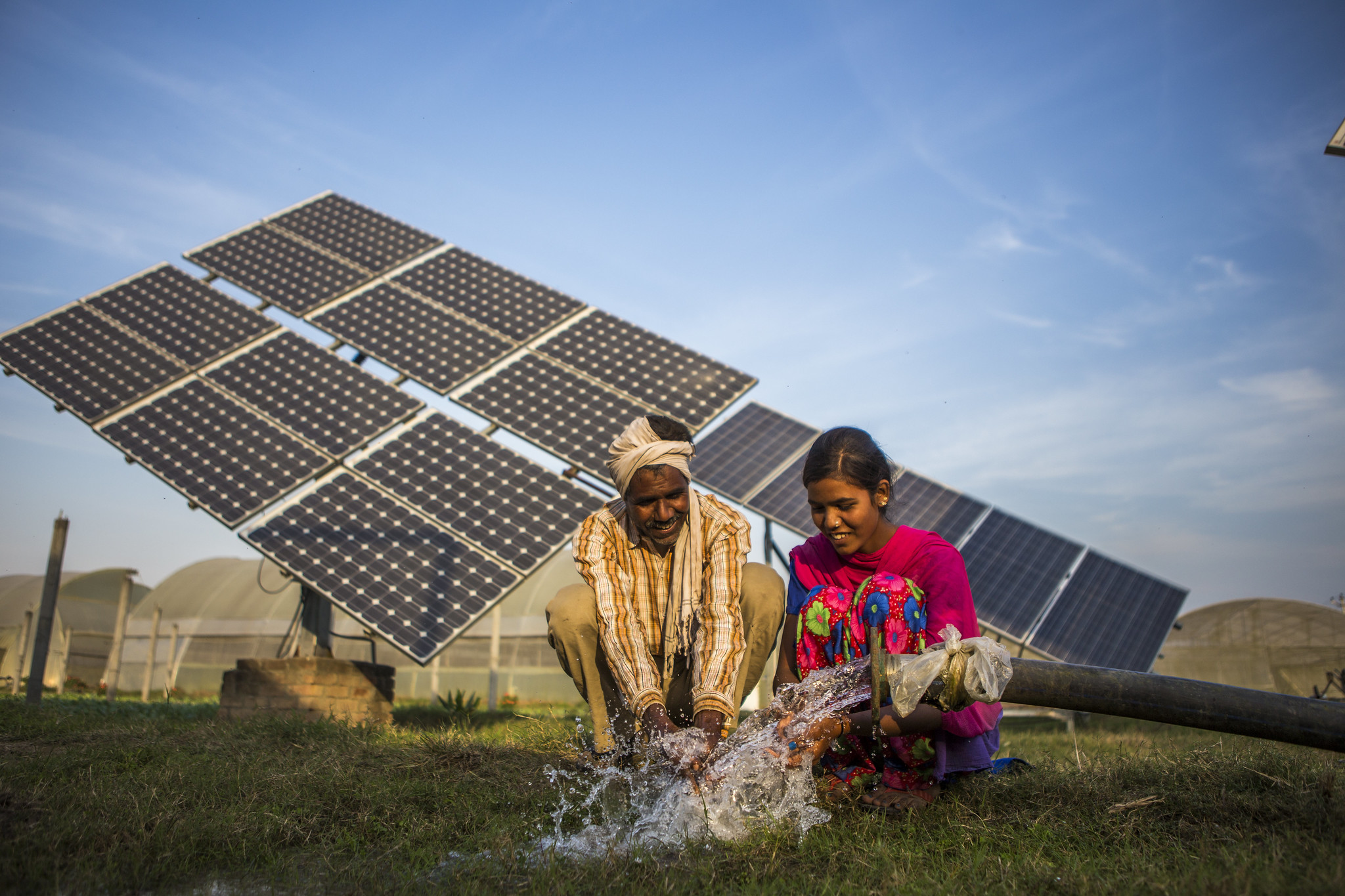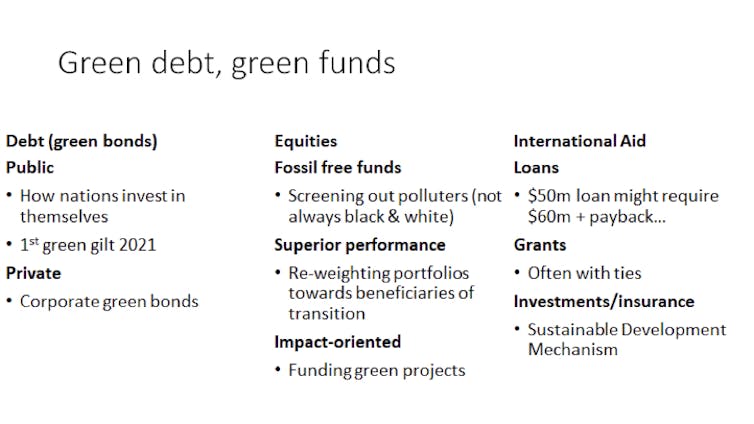The almost mystical Green Climate Fund is back in the headlines at the COP26 climate summit in Glasgow. The fund grew out of a promise made by rich nations in 2009 to provide US$100 billion (£74 billion) per year in “climate finance” to help developing countries to decarbonise their economies. So far, the amount actually raised has fallen far short, though we might at least get there soon.
Climate finance is notoriously tricky to define. It’s rarely clear how much is really available, or how much is actually needed. So where does this money come from, and can those richer nations even afford it, especially following the COVID-19 pandemic?
The lack of a consistent, globally accepted definition of what counts as climate finance has led to a wild west scenario, making it impossible to calculate how much is really out there and how environmentally friendly it really is. Governments and fund managers alike can attach “green” labels to investments in new airports or “green” funds with large stakes in fossil fuel companies. Some of this is likely to be blatant greenwash. But some of it simply reflects real-world complexity: if fossil-fuel majors raise finance to decarbonise their portfolios by building wind and solar farms, should this be considered “green”?
There are three broad categories of climate finance. The first is debt, which can be public (governments issuing bonds) or private (companies issuing bonds). A second category comes from shares and private capital. This can take many forms, but often includes “green funds” that screen out polluting firms and industries.
The final category, and one that is a key interest at COP26, is the role of international aid in providing finance to help developing countries decarbonise –for example by phasing out coal, developing low-carbon transport, or restoring ecosystems such as mangroves that buffer against floods and storms.
In principle, climate-oriented international aid can take the form of grants, loans or direct investments and insurance, each with varying degrees of strings attached. In practice, however, these categories are highly controversial. Take for example a hypothetical US$50 million loan from the US to India for a new solar farm, which is to be repaid with US$10 million in interest. From the US perspective, US$50 million of climate finance has been provided. From India’s perspective, it received US$50 million but will ultimately send US$60 million to the US, prompting the question of who is financing whom.
Three categories of climate finance. Kamiar Mohaddes et al, Author provided
What is the Green Climate Fund and does it matter?
At COP15 in Copenhagen in 2009, rich countries promised to provide US$100 billion a year by 2020, which led to the formal establishment in 2010 of the Green Climate Fund with the aim to support developing economies to address climate change. Whatever metric or definition of climate finance you use, we have clearly not achieved the goal of US$100 billion a year yet. That figure will instead be reached in 2023 according to the latest estimates, though some at COP26 are more optimistic: both the EU’s Ursula von Leyden and US climate envoy John Kerry have said the goal will be met in 2022.
A tree planting project in Rwanda, financed by the Green Climate Fund. Rwanda Ministry of Environment, CC BY-SA
However, because there’s no clear definition of what counts as climate finance, there are huge discrepancies in estimates of what has been committed so far. The OECD estimate (which is what the COP26 climate finance delivery plan is based on) is at the upper end, while Oxfam estimates that just over one-fifth of what has been promised has materialised so far.
How much is actually needed
Estimates of the amount of finance needed to actually decarbonise the global economy range between US$50 trillion and US$90 trillion. With a thousand billions in a trillion, that US$100 billion everyone is referring to is merely a decimal point.
It is also near impossible to figure out exactly how much green finance will be needed, since the total amount required depends on where the money goes and how soon we spend it. Early investments in new technologies generate rapid cost reductions and will reduce asset stranding (wasted investments in already obsolete carbon-intensive infrastructure). Further delay simply slows innovation and compounds the climate crisis.
Climate change will shrink the economies of rich, poor, hot and cold countries alike and will make it more difficult and more expensive to raise the finance needed to decarbonise in the future. The cost of early action is far cheaper than the cost of delayed action.
We have just seen a comprehensive and coordinated cross-country policy response to the pandemic, with more than US$16 trillion of government support rolled out globally (and at super-fast speed). Climate change will require the same coordinated response, and the pandemic response shows that significant financing for decarbonisation can be relatively quickly mobilised.
The bottom line is that mobilising climate finance is a win-win for both the developed and developing economies. And in the context of what will really be needed to address climate change, that US$100 billion is really just a distraction.
 Kamiar Mohaddes receives funding from the Keynes Fund and INSPIRE.
Kamiar Mohaddes receives funding from the Keynes Fund and INSPIRE.
Matt Burke receives funding from the INSPIRE Network.
Matthew Agarwala receives funding from the ESRC, The Productivity Institute, and the INSPIRE Network.
Patrycja Klusak receives funding from the INSPIRE Network.
Kamiar Mohaddes, Associate Professor in Economics & Policy, University of Cambridge



 China’s Power Market Revamp Fuels Global Boom in Energy Storage Batteries
China’s Power Market Revamp Fuels Global Boom in Energy Storage Batteries  China Keeps Benchmark Lending Rates Steady as Economic Outlook Remains Cautious
China Keeps Benchmark Lending Rates Steady as Economic Outlook Remains Cautious  BOJ Governor Signals Gradual Rate Hikes as Japan’s Inflation Nears 2% Target
BOJ Governor Signals Gradual Rate Hikes as Japan’s Inflation Nears 2% Target  Japan Plans $189 Billion Bond Issuance as Record Budget Signals Expansionary Fiscal Policy
Japan Plans $189 Billion Bond Issuance as Record Budget Signals Expansionary Fiscal Policy  Wall Street Ends Higher as S&P 500, Nasdaq Extend Gains Ahead of Holiday Week
Wall Street Ends Higher as S&P 500, Nasdaq Extend Gains Ahead of Holiday Week  U.S. Stock Index Futures Steady After S&P 500 Hits Record on Strong Economic Data
U.S. Stock Index Futures Steady After S&P 500 Hits Record on Strong Economic Data  Why U.S. Coffee Prices Are Staying High Despite Trump’s Tariff Rollbacks
Why U.S. Coffee Prices Are Staying High Despite Trump’s Tariff Rollbacks  South Korea Central Bank Warns of Rising Financial Stability Risks Amid Won Volatility
South Korea Central Bank Warns of Rising Financial Stability Risks Amid Won Volatility  Global Markets Rise as Tech Stocks Lead, Yen Strengthens, and Commodities Hit Record Highs
Global Markets Rise as Tech Stocks Lead, Yen Strengthens, and Commodities Hit Record Highs  UK Economy Grows 0.1% in Q3 2025 as Outlook Remains Fragile
UK Economy Grows 0.1% in Q3 2025 as Outlook Remains Fragile  BOJ Minutes Reveal Growing Debate Over Interest Rate Hikes and Inflation Risks
BOJ Minutes Reveal Growing Debate Over Interest Rate Hikes and Inflation Risks  Yen Stabilizes Near Lows as Japan Signals Readiness to Intervene Amid Dollar Weakness
Yen Stabilizes Near Lows as Japan Signals Readiness to Intervene Amid Dollar Weakness  Platinum Price Surges Past $2,000 as Demand and Supply Dynamics Tighten
Platinum Price Surges Past $2,000 as Demand and Supply Dynamics Tighten  US and Japan Fast-Track $550 Billion Strategic Investment Initiative
US and Japan Fast-Track $550 Billion Strategic Investment Initiative  Oil Prices Ease in Asia as Geopolitical Risks Clash With Weak Demand Outlook
Oil Prices Ease in Asia as Geopolitical Risks Clash With Weak Demand Outlook 































